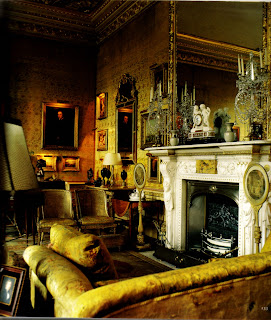Below are some of my favorite rooms from the book; in fact, there were so many that it was hard to choose.
 The private bath of Madeleine Castaing at her shop on the Rue Jacob
The private bath of Madeleine Castaing at her shop on the Rue Jacob Chatsworth- home of the Duchess of Devonshire
Chatsworth- home of the Duchess of Devonshire
 London home of Lady Diane Cooper
London home of Lady Diane Cooper
 Portrait of Lady Diana Cooper (I included this photo not just because of Cooper's peculiar choice of hats, but also because of the trompe l'oeil panels behind her that were painted by Rex Whistler).
Portrait of Lady Diana Cooper (I included this photo not just because of Cooper's peculiar choice of hats, but also because of the trompe l'oeil panels behind her that were painted by Rex Whistler). Bedroom of Nancy Lancaster, located in her private quarters at Colefax and Fowler in Mayfair
Bedroom of Nancy Lancaster, located in her private quarters at Colefax and Fowler in Mayfair Villa Trianon, home of Elsie de Wolfe
Villa Trianon, home of Elsie de Wolfe







Nancy Lancaster, a woman with an artistic mind that never rested! Look closely and you will see she has placed a Queen Ann chair over a toilet (see the tank behind the chair back). Her bedroom is my favorite picture.
ReplyDeleteLove the images you used here. Especially Villa Trianon.
ReplyDeleteLouise- it's so funny that you mentioned Lancaster's toilet. There is a French term for that type of toilet (a formal type chair which concealed the commode). I can't think of the proper term right now- do you know what it is? I actually have been searching for something similar b/c I thought it might be amusing, but don't know what others might think about it! David Hicks used this type of chair/toilet in his bathrooms, but the chair was more of a cane-type chair.
ReplyDeleteStyle Court- Thanks. I too like the Villa Trianon photo. There are other photos of her home in the book, but this one was my favorite.
ReplyDeleteLove the bedroom of Nancy Lancaster and Elsie de Wolfe's Villa Trianon. Thanks for sharing!
ReplyDeleteI believe it's called a French style commode or toilet chair, wood & cane construction.
ReplyDeleteI recall seeing David Hicks' bathroom and the chair you speak of.
Personally, I've never favored wooden toilet seats and I absolutely love my Toto Aquia which has a seat that closes slowly just by a soft touch -- highly recommended for a house full of men!
Thank you for the link to Derry Moore. Lovely post!
ReplyDeleteLouise, I have to agree with you about wooden toilet seats!
ReplyDeleteThanks for the comment Paris Breakfasts!
ReplyDeleteHello, I'm new to your blog and I just wanted to say that the rooms you posted are divine. All of Nancy's bedrooms were amazing and that's one of my favorites. I just love the photo from Chatsworth, too. Thanks for the great photos---your blog is wonderful!
ReplyDeleteAlexandrina- thank you for your kind comment! I'm glad you found my blog and I look to hearing your comments!
ReplyDeleteLove that London home esp!
ReplyDeleteNice photo of Lady Diana Cooper~she was pushing ninety at the time.
ReplyDeleteThe trompe l'oeil panels were painted by Martin Battersby, not Rex Whistler as the caption stated.
They provided the endpapers to her 3 volumes of autobiography.
Toby- I admire her hat, which I believe was her husband's. And this is very interesting about Battersby painting the panels, not Whistler. I went back to "Rooms" and the author credits the panels to Whistler with no mention of Battersby. I'm not very familiar with Battersby, but obviously now I realize I need to be! Thank you.
ReplyDeletePart of the confusion may stem from the fact that Rex Whistler painted trompe l'oeil on to the plaster walls of Lady Diana and Duff Cooper's Gower St drawing room in the 1930s. That building was pulled down, but I've learned that the painted trophies, rondels and faux engraved maps were cut out of the plaster and preserved at London University. Source: The Work of Rex Whistler( Batsford Pub,1960)
ReplyDeleteToby- Aha! I obviously need to read the Whistler book.
ReplyDelete